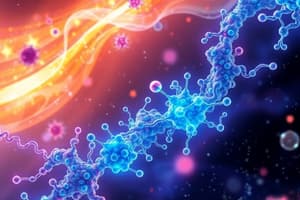Podcast
Questions and Answers
Which process involves compounds conjugated with acetic acid?
Which process involves compounds conjugated with acetic acid?
- Methylation
- Acetylation (correct)
- Sulfation
- Skatoxylation
What is the active form of acetic acid in acetylation reactions?
What is the active form of acetic acid in acetylation reactions?
- Phenyl sulphate
- PAP
- PABA
- Acetyl coA (correct)
Which enzyme catalyzes the sulfation process?
Which enzyme catalyzes the sulfation process?
- Glucuronidase
- Sulfotransferase (correct)
- Methylase
- Acetyl transferase
What is the active form of sulfate in conjugation reactions?
What is the active form of sulfate in conjugation reactions?
Which drug can induce Bilirubin-UGT activity?
Which drug can induce Bilirubin-UGT activity?
Which compound is conjugated with bilirubin to form bilirubin diglucuronide?
Which compound is conjugated with bilirubin to form bilirubin diglucuronide?
Which of these compounds is a tranquilizer?
Which of these compounds is a tranquilizer?
How is sulfation different from acetylation and methylation?
How is sulfation different from acetylation and methylation?
What is the compound that undergoes acetylation with Acetyl coA?
What is the compound that undergoes acetylation with Acetyl coA?
Study Notes
Metabolism of Xenobiotics
- Xenobiotics are foreign compounds like drugs, pollutants, food additives, cosmetics, pesticides, etc. that enter the body accidentally or intentionally.
- These compounds may be absorbed from the GI tract and enter the organs and tissues of the body, and thus need to be removed quickly.
Detoxification (Biotransformation)
- Detoxification is the process of converting foreign, toxic, and water-insoluble molecules into non-toxic, water-soluble, and excretable forms.
- The purpose of detoxification is to increase the water solubility (polarity) and thus facilitate excretion from the body.
- However, in some cases, detoxification reactions may increase the toxicity of a foreign compound, which is called entoxification.
Medical Importance of Detoxification
- Detoxification reduces the level of toxins in the body, protecting the body and its organs from deleterious effects of toxins.
- Reducing toxin levels in the body reduces the strain on the immune system.
- Detoxification removes most of the drugs consumed from the body.
Methanol Toxicity
- The metabolism of formic acid is slow, leading to accumulation in the body, which results in metabolic acidosis.
- The major damage occurs to the optic nerve.
- Ethanol is given as an antidote, as it is a substrate of ADH, which spares methanol.
Oxidation of Xenobiotics
- Aldehydes are oxidized to corresponding acids.
- Oxidation of aromatic hydrocarbons forms phenolic compounds, which can further conjugate with glucuronic acid (or) sulfuric acid in phase II reactions.
- Primary aliphatic amines undergo oxidation to form the corresponding acids and nitrogen is converted to urea.
- Anilids are oxidized to corresponding phenols.
- Sulfur compounds: Organic sulfur is oxidized to sulfuric acid.
Oxidation (Entoxification)
- Oxidation of certain compounds may result in the production of more toxic compounds (entoxification).
- Halogenated alcohols are oxidized to halogenated acids.
- Ethylene glycol is oxidized to oxalic acid.
Cytochrome P450
- Most oxidation reactions of detoxification are catalyzed by monooxygenase (or) cytochrome P450.
- Cytochrome P450 is a hemoprotein, exhibiting broad substrate specificity and versatility as a catalyst.
- It is located in the smooth ER of the liver and other tissues.
- It is a NADPH-dependent enzyme, and the products of some reactions may be mutagenic or carcinogenic.
- It is an inducible enzyme, and its synthesis is increased by administration of drugs such as phenobarbitol.
Reduction
- Reduction is less common and less important than oxidation in human beings.
- Examples of reduction reactions include the reduction of aldehydes and nitro compounds.
Hydroxylation
- Detoxification of a number of drugs and steroids occurs by hydroxylation.
- These reactions are catalyzed by cytochrome P450-dependent monooxygenases.
Hydrolysis
- Certain therapeutic compounds undergo hydrolysis, including ester, glycoside, and amide bonds.
- Examples of compounds undergoing hydrolysis include aromatic acids, phenols, secondary and tertiary aliphatic alcohols, antibiotics, hormones, and carcinogens.
Conjugation with Bilirubin
- Most of the bilirubin excreted in the bile is in the form of bilirubin diglucuronide.
- Bilirubin-UGT activity can be induced by certain drugs, which increases the formation of glucuronide.
Sulfation
- Compounds conjugated with sulfate include phenols, cresols, indole, steroids, oestrogen, and androgen.
- The active form of sulfate is 3’phosphoadenosine 5’phosphosulfate (PAPS), which is involved in conjugation reactions catalyzed by sulfotransferase.
Acetylation
- Compounds conjugated with acetic acid include sulphanilamide, PABA, and isoniazid.
- Acetyl coA is the active form of acetic acid, and the reactions are catalyzed by acetyl transferase in the cytosol of various tissues, particularly the liver.
Studying That Suits You
Use AI to generate personalized quizzes and flashcards to suit your learning preferences.
Description
This quiz covers the introduction to the metabolism of xenobiotics, which are foreign compounds encountered by human beings through various sources like drugs, pollutants, and food additives. Understand the process of absorption and circulation of xenobiotics in the body.




